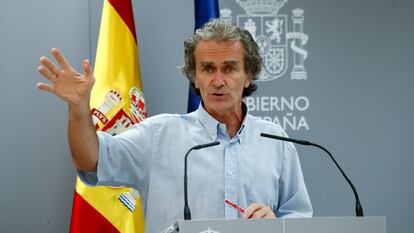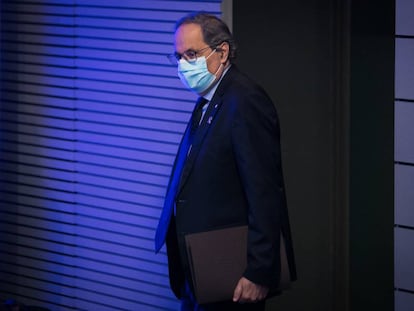Ministry: Madrid must take ‘drastic measures’ if coronavirus cases continue to rise
Spain has now confirmed 405,000 positive cases since the epidemic took hold in March, with 46,000 new infections detected since last Monday

Spain has started the week just as the last one finished: watching the general rise in nearly all of the indicators that measure the spread of a second wave of the coronavirus with concern. Since last Monday, a total of 46,000 cases have been diagnosed – an increase of 13% of the total since the epidemic took hold. The country has so far confirmed 405,000 positive cases since the month of March.
Madrid continues to be the focal point of the health crisis, and has registered 15,000 new cases in just a week, a rise of 16.1% to 108,000 cumulative diagnoses. The region has 300 more hospitalizations since last Thursday, when the Health Ministry began to offer detailed information on this data point, which is a rise of 24% in four days, to a total of 1,544 patients. This figure is 12% of the total capacity of the region’s hospitals. Admissions in intensive care units (ICUs) are currently at 165, 31% more than on Thursday.
The rising trend is present in a large number of the regions, but it is true that in some of them we are observing the stabilization of the number of casesFernando Simón, director of the Health Ministry’s Coordination Center for Health Alerts
The Madrid region on Sunday opted to confine the small municipality of Tielmes on Sunday, a measure that, according to the Health Ministry, might not be the last that needs to be adopted. “It’s true that in other municipalities, which form part of the larger metropolitan Madrid, it’s more difficult to apply this type of measure, but of course if the incidence continues to rise, drastic measures will have to be taken,” said on Monday Fernando Simón, the director of the Health Ministry’s Coordination Center for Health Alerts (CCAES), during one of his regular press conferences on the coronavirus crisis. “I don’t know if it will be a lockdown or of another type, without restricting mobility beyond the perimeter. I’m sure that the Madrid region has all of the options on the table.”
One of the few pieces of good news reported on Monday by the ministry is that the spread of the virus is slowing in regions that have been in a poor epidemiological situation, such as Aragón and part of Catalonia. This shows that carrying out mass PCR tests and tracing contacts can improve even the most pessimistic of scenarios. The cost, however, is the need for more restrictions, such as those announced on Monday by the Catalan regional premier, Quim Torra, which will prohibit meetings of more than 10 people apart from for reasons of transport, work or education.

But the situation is clearly getting worse in the rest of the country, in particular in areas that began with a better epidemiological situation. The best example is Murcia, which, since Thursday, has seen the number of ICU patients triple, to 31. Its hospital admissions are also up 131% and positive cases have risen 25%. All of this yesterday prompted the regional government to limit social meetings to six people.
The effect of the pandemic has also notably increased in the Balearic Islands, where hospitalizations have risen 43%, the Canary Islands, where hospitalizations are up 30% and ICU admissions up 69%, Castilla-La Mancha (hospitalizations up 45%) and Castilla y León (hospitalizations up 26%). The latter two regions, however, saw lower rises than the remainder in terms of new cases: around 10% for the last seven days. This would suggest that the measures implemented to control infections are taking effect. Experts explain that hospitalizations and mortality begin to rise two or three weeks after new cases do.
The indicators are also promising in Cantabria, Asturias, Galicia and Extremadura, but they have begun to rise in Andalusia. In the Basque Country, the situation continues to be complicated and the number of new cases has risen 16% in a week, with hospitalizations up 21% since Thursday to 404, which is 10% of the health service’s capacity. ICU admissions have risen 37%, to 37, since Thursday.
Madrid continues to be the focal point of the health crisis, and has registered 15,000 new cases in just a week
“The rising trend is present in a large number of the regions, but it is true that in some of them we are observing the stabilization of the number of cases and in the weekly incidence,” Simón explained on Monday.
The data for the country as a whole, however, paints a mostly worrying picture. The cumulative incidence in the last 14 days, which is one of the variables most used to compare the situation with other countries, continues to rise and is currently at 166 cases per 100,000 inhabitants.
The number of people who have begun to suffer symptoms in the last two weeks, however, has fallen slightly. The ministry does not supply data over the weekend, but on Friday, this figure was at 21,659 and on Monday it was just under 21,000. This data point is also closely observed by the experts to monitor the progress of the epidemic, given that it offers the most recent indicator of the health crisis. This fall, after many days on the rise, is, in principle, positive. More days are needed, however, before it can be determined whether this is a solid change of trend.
The number of Covid-19-related fatalities, meanwhile, came in at 96 for the last seven days in Monday’s report, which is 34 more than Friday. This data, however, is not representative of the real situation given that the global total supplied by the Health Ministry continues to suffer considerable delays compared to the numbers being announced by the regions themselves.
Simón also explained on Monday that he expected there to be fewer cases of common colds and the regular flu this fall and winter, given the obligatory requirement to wear masks in public. “We will continue to wear them, which means that the risks will be reduced,” the CCAES director explained.
As for the return to schools in September, Simón admitted that the reopening of classrooms could see “the virus transmitted more easily,” but he pointed to the planned upcoming meetings between the central government and Spain’s regional authorities, which are aimed at ensuring that children “can return to school with sufficient safety measures so that this doesn’t mean any risks for the population.”
English version by Simon Hunter.
Tu suscripción se está usando en otro dispositivo
¿Quieres añadir otro usuario a tu suscripción?
Si continúas leyendo en este dispositivo, no se podrá leer en el otro.
FlechaTu suscripción se está usando en otro dispositivo y solo puedes acceder a EL PAÍS desde un dispositivo a la vez.
Si quieres compartir tu cuenta, cambia tu suscripción a la modalidad Premium, así podrás añadir otro usuario. Cada uno accederá con su propia cuenta de email, lo que os permitirá personalizar vuestra experiencia en EL PAÍS.
¿Tienes una suscripción de empresa? Accede aquí para contratar más cuentas.
En el caso de no saber quién está usando tu cuenta, te recomendamos cambiar tu contraseña aquí.
Si decides continuar compartiendo tu cuenta, este mensaje se mostrará en tu dispositivo y en el de la otra persona que está usando tu cuenta de forma indefinida, afectando a tu experiencia de lectura. Puedes consultar aquí los términos y condiciones de la suscripción digital.
More information
Últimas noticias
Alain Aspect, Nobel laureate in physics: ‘Einstein was so smart that he would have had to recognize quantum entanglement’
Imelda Castro, the woman who wants to rule the cartel battleground of Sinaloa
The new victims of the Republican war on Obamacare: Millions hit by soaring health insurance premiums
A country divided on migrant rights: Some US states expand protections while others restrict them
Most viewed
- David King, chemist: ‘There are scientists studying how to cool the planet; nobody should stop these experiments from happening’
- Reinhard Genzel, Nobel laureate in physics: ‘One-minute videos will never give you the truth’
- Oona Chaplin: ‘I told James Cameron that I was living in a treehouse and starting a permaculture project with a friend’
- Sinaloa Cartel war is taking its toll on Los Chapitos
- Mexico completes its trade shift with the entry into force of tariffs on China and countries without trade agreements










































